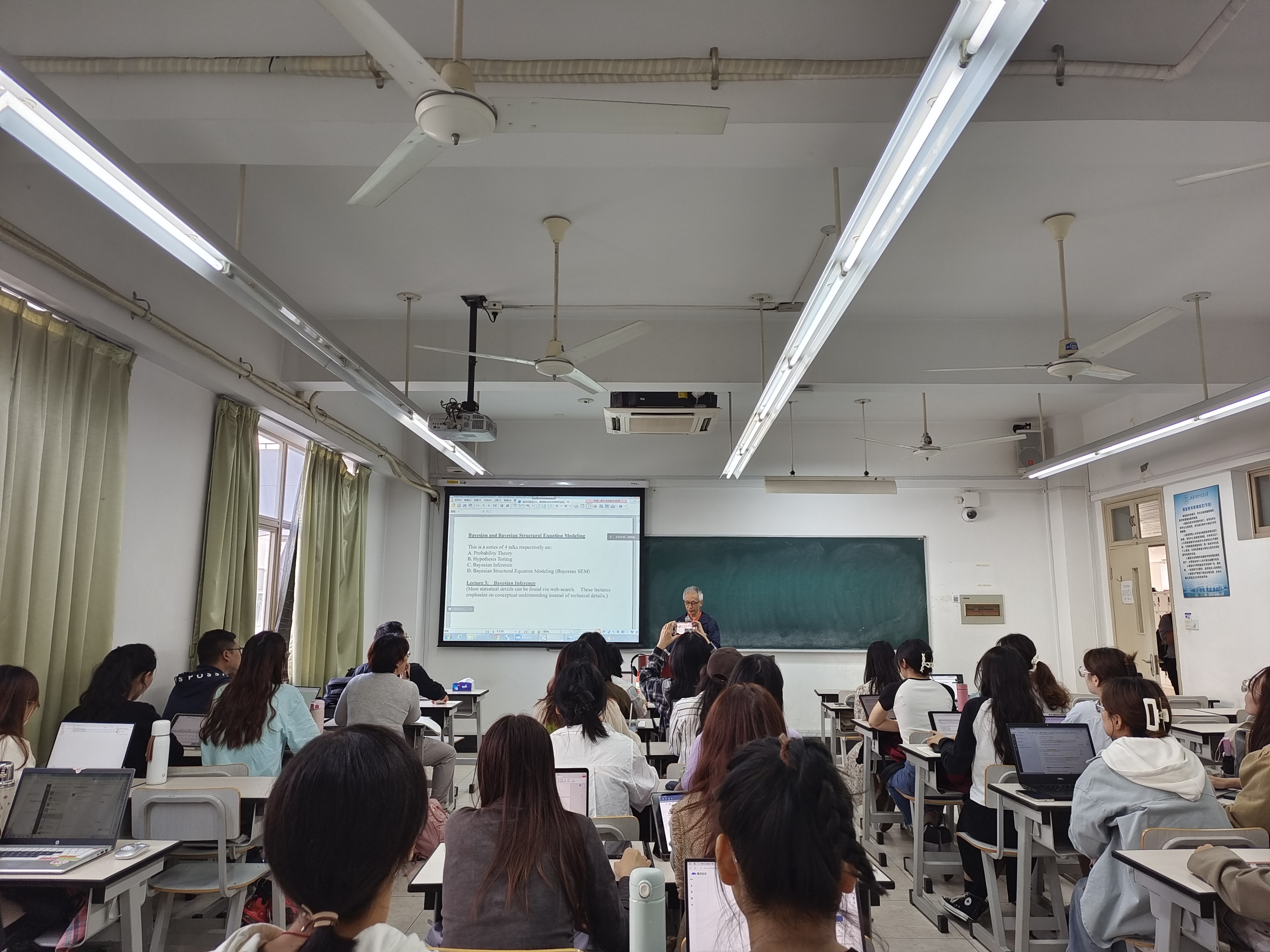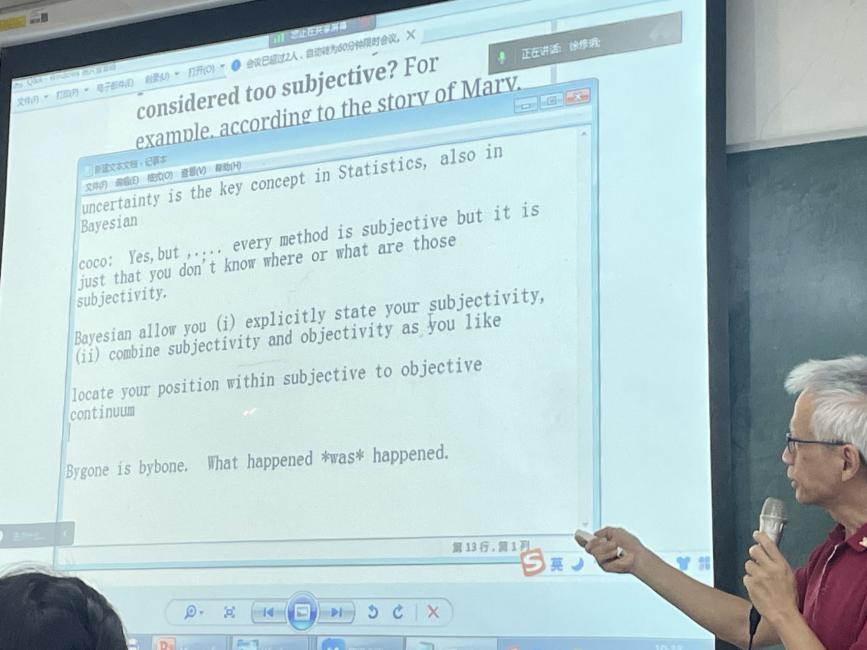2023年11月2日和11月3日,澳门大学教育学院梁成安副教授应上海对外经贸大学语言教育与测评中心(CLEAR) 邀请,为我院师生进行了两场主题为 “贝叶斯和贝叶斯结构方程模型”的线下讲座。本次讲座由上海对外经贸大学CLEAR中心主任蔡雨阳教授主持,选修应用语言学前沿课程的全部学生及我校和上海外国语大学的近30名师生在教学楼SA201 和SA204 参加了此次讲座。
On November 2 and 3, 2023, Associate Professor LEUNG Shing On of the School of Education, University of Macau, gave two offline lectures on “Bayesian and Bayesian Structural Equation Modeling” for teachers and students of the School of Languages at the invitation of CLEAR, Shanghai University of International Business and Economics. The lecture was hosted by Professor CAI Yuyang, Director of CLEAR. Approximately 30 students and teachers who take Frontiers in Applied Linguistics and come from Shanghai International Studies University attended the lectures in SA201 and SA204.

讲座一共分为两场,分别在11月2日和11月3日进行。
The lecture was divided into two sessions, one on November 2 and the other on November 3.
第一场讲座初始,梁教授首先进行了自我介绍,并介绍了自己在教育学和统计领域的研究经验。他利用多个生活中的有趣例子引入了贝叶斯这一主题,使参会者们对该主题产生了浓厚的兴趣。之后,梁教授通过几个生动的示例深入讲解了贝叶斯相关概念,包括贝叶斯思维方式的基本原理和与经典假设检验的区别。参会者们通过实际案例逐渐理解了贝叶斯。其主要概念包括先验概率、似然度和后验概率。
At the beginning of the first lecture, Professor Leung first introduced himself and introduced his research experience in the field of education and statistics. Using many interesting examples from life, he led on the topic of Bayesian, which aroused the participants’ strong interest in the topic. Professor Leung then explained Bayesian concepts in depth through several vivid examples, including the basic principles of Bayesian thinking and the differences from classical hypothesis testing. The participants gradually understood the Bayesian through practical cases. Its main concepts include prior, likelihood, and posterior.

第二场讲座主要涉及贝叶斯结构方程模型的应用。讲座开始,梁教授首先回答了同学的疑问,“请问有无衡量先验概率合理性的标准呢?否则,贝叶斯会被认为过于主观吗?”梁教授对此的回答是,“每种方法都是主观的,但只是你不知道这些主观性在哪里或是什么。贝叶斯允许你明确陈述你的主观性,并根据需要将主观性和客观性结合起来。”
The second session of the lecture dealt with the application of Bayesian Structural Equation Modeling (BSEM). At the beginning of this lecture, Professor Leung answered a question from students, “Are there any criteria for measuring the reasonableness of prior? Otherwise, can Bayesian be considered too subjective? ” For this question, Professor Leung’s reply was that every method was subjective, but it was just that you didn’t know where or what were those subjectivities. Bayesian allows you to explicitly state your subjectivity and combine subjectivity and objectivity as you like.
接下来,梁教授简要介绍了贝叶斯中的关键概念,如先验概率、似然度、后验概率、收敛性、模型评估、贝叶斯因子和贝叶斯信息准则(BIC),然后深入讲解了如何使用贝叶斯结构方程模型(BSEM)并且用SPSS 26给参会者展示了贝叶斯处理数据的一些基本操作。参会者不仅对贝叶斯应用有了初步的了解,还对使用BSEM的原因和优势进行了深入讨论。
Next, Professor Leung briefly introduced the key concepts in Bayesian, such as prior, likelihood, posterior, convergence, model evaluation, Bayesian factors, and Bayesian Information Criterion (BIC), and then explained Bayesian Structural Equation Modeling (BSEM) in detail and showed some operations of BSEM using SPSS 26. Participants had a preliminary understanding of BSEM data analysis and had an in-depth discussion on the reasons and advantages of using BSEM.

在问答环节中,学生们积极提问,与梁教授进行了深入交流,进一步加深了对贝叶斯和贝叶斯结构方程模型的理解。整个讲座过程中,梁教授和同学们积极互动,梁教授幽默的表达给大家留下深刻印象,现场气氛融洽。
During the Q&A session, the students actively asked questions and had in-depth exchanges with Professor Leung, which further deepened their understanding of Bayesian and Bayesian Structural Equation Modeling. During the whole lecture, Professor Leung interacted with the students, and his humorous style of expression left a deep impression on everyone. The atmosphere was harmonious.
讲座最后,蔡雨阳教授代表CLEAR及上经贸大国际商务外语学院再次对梁教授表示感谢,他分享的宝贵知识和经验使在场师生获益良多。这次研讨会为本院师生提供了一个学习贝叶斯和贝叶斯结构方程模型的宝贵机会。
At the end of the lecture, Professor Cai Yuyang, on behalf of CLEAR and the School of Languages, expressed gratitude to Professor Leung for sharing his valuable knowledge and experience. This seminar provided a valuable opportunity for our faculty and students to learn about Bayesian and Bayesian Structural Equation Modeling.
撰稿人:王攀 陈艳 左巧玲 徐修玥
Contributed by:WANG Pan CHEN Yan ZUO Qiaoling XU Xiuyue
